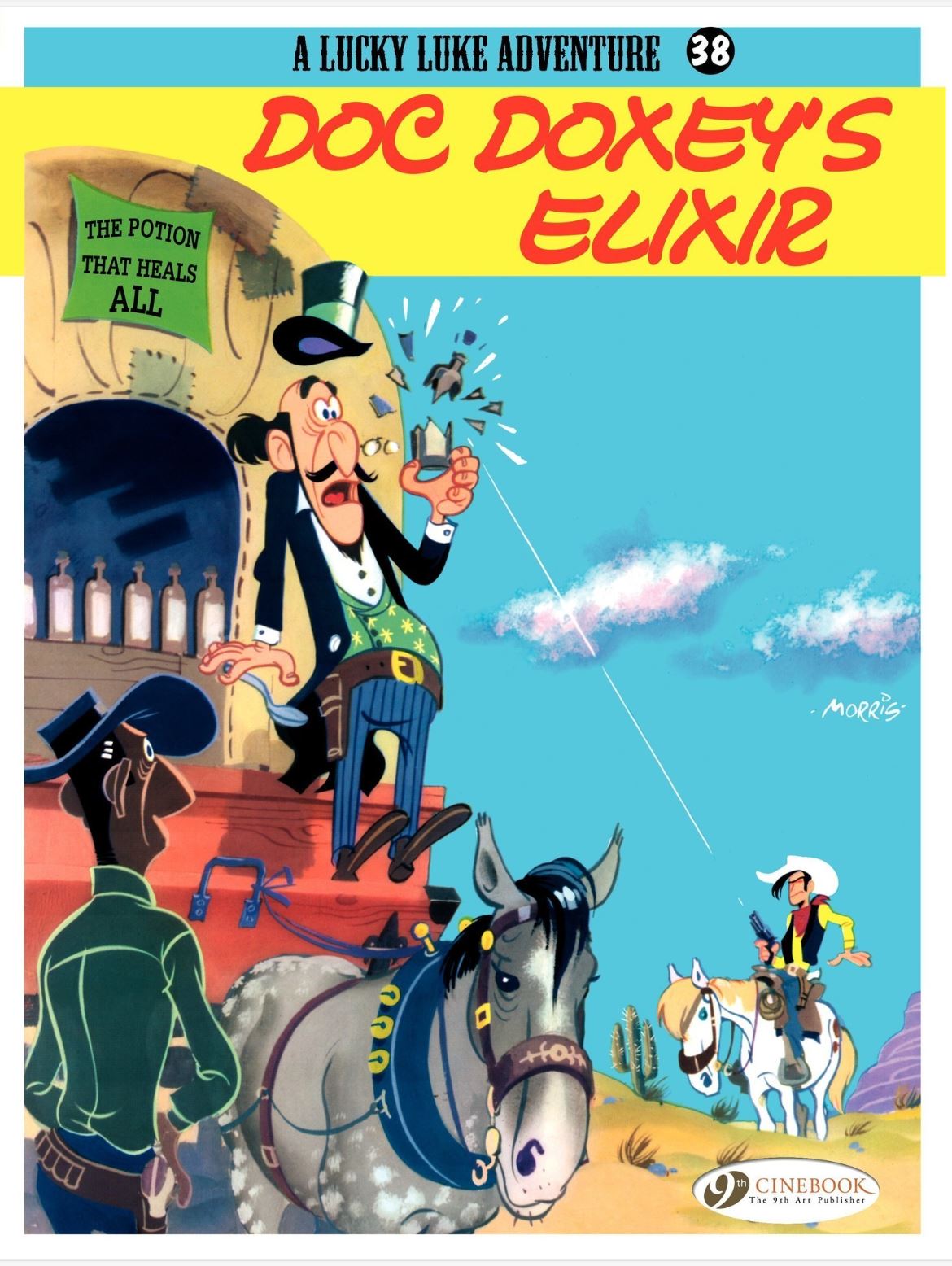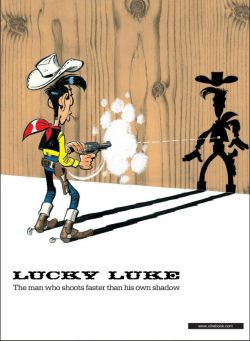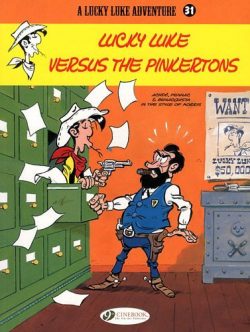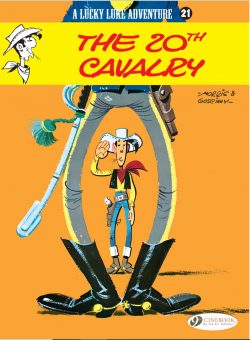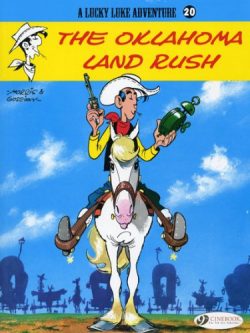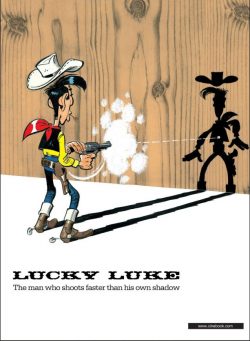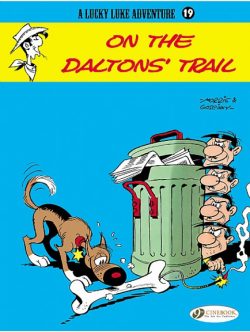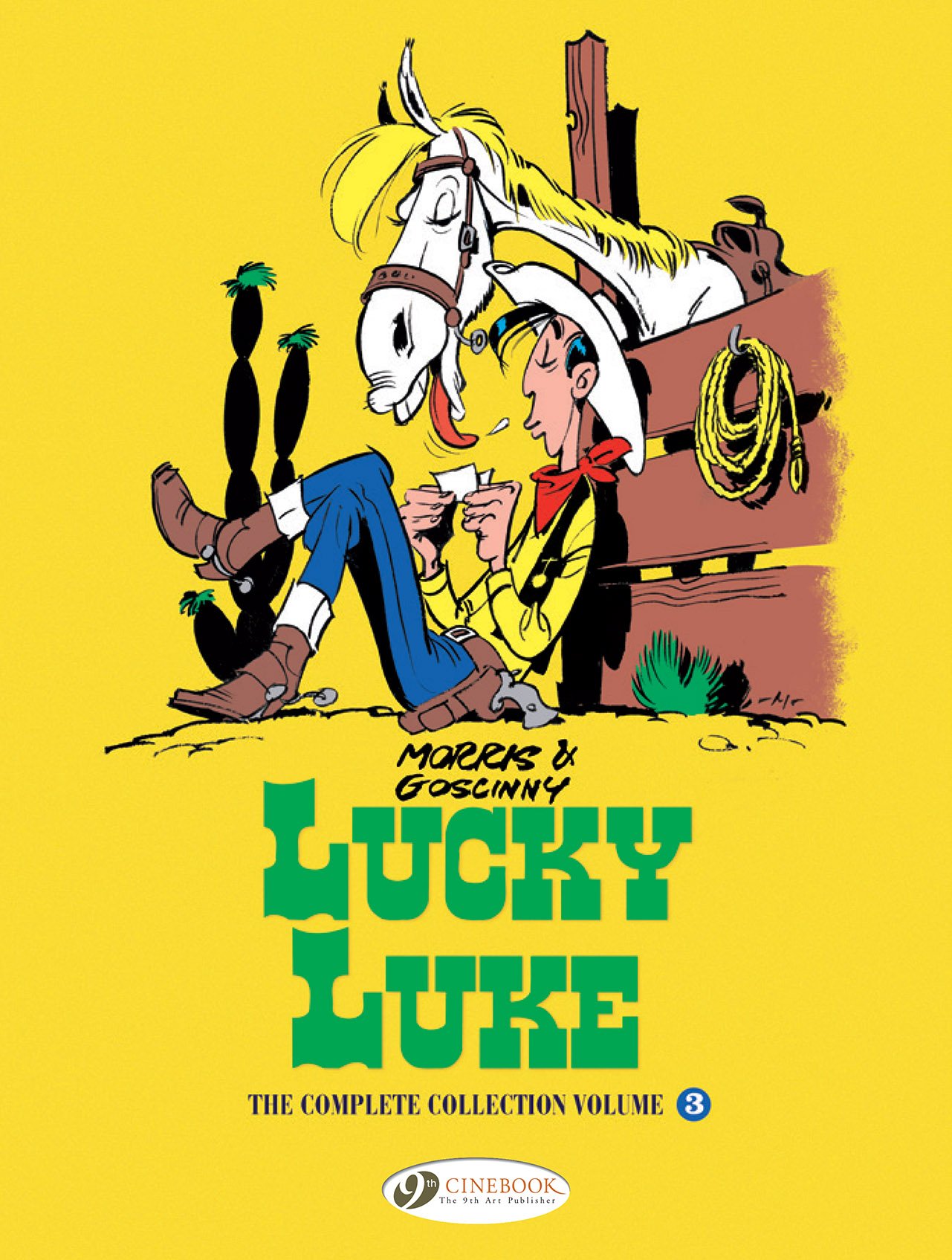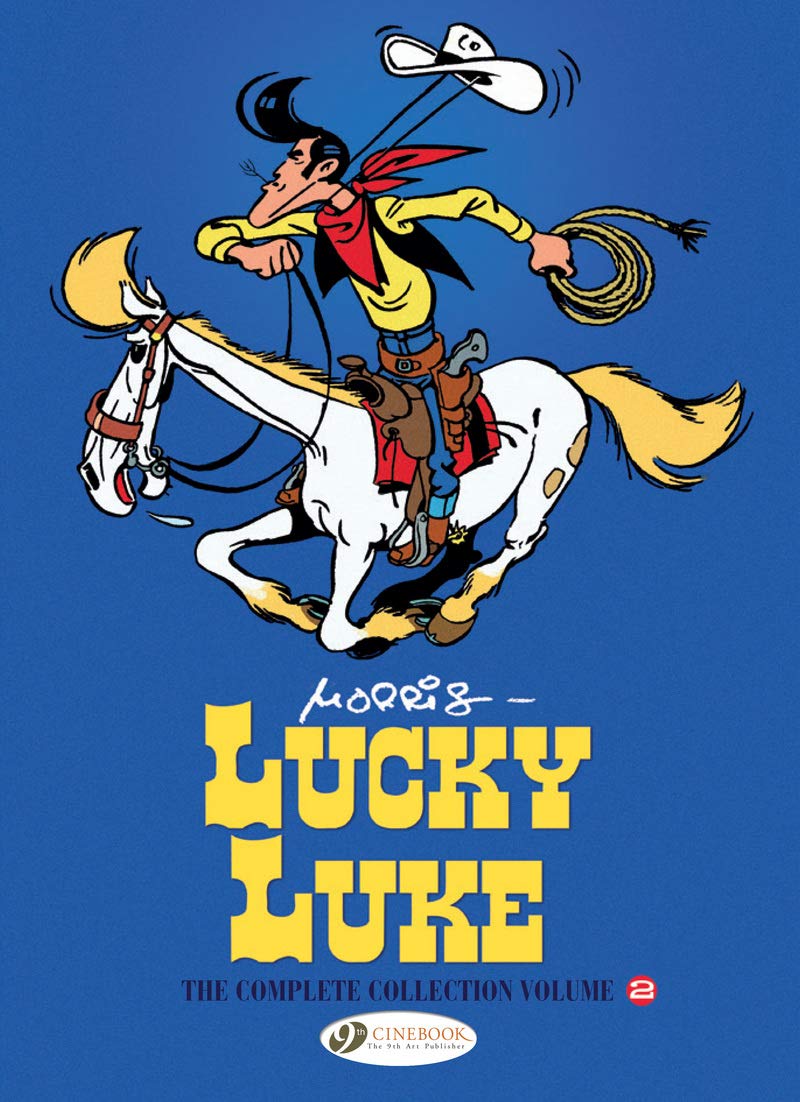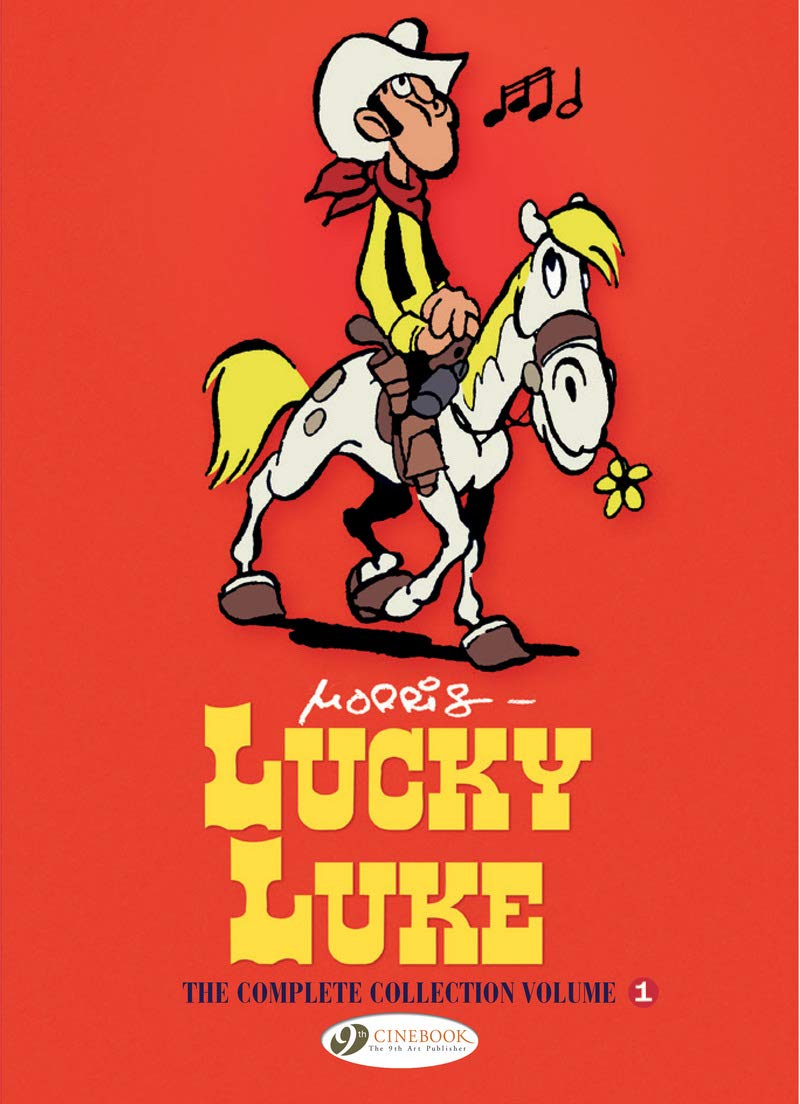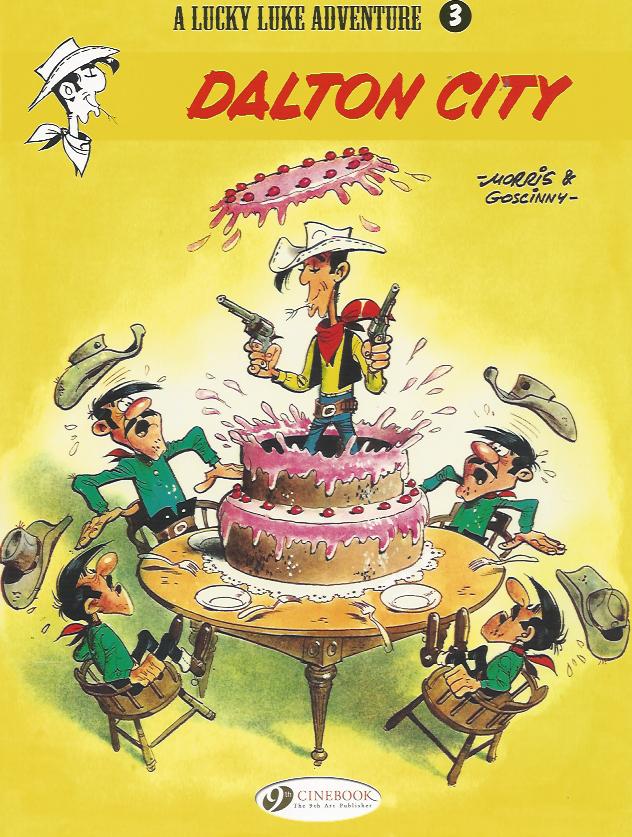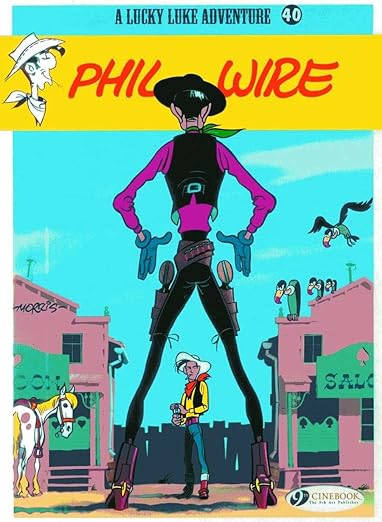
By Morris, translated by Erica Jeffrey (Cinebook)
ISBN: 978-1-84918-155-6 (Album PB/Digital edition)
Doughty, dashing and dependable cowboy “good guy” Lucky Luke is a rangy, implacably even-tempered do-gooder able to “draw faster than his own shadow”. He amiably ambles around the mythic Old West, enjoying light-hearted adventures on his petulant and rather sarcastic wonder-horse Jolly Jumper. Over nine decades, his exploits have made him one of the top-ranking comic characters in the world, generating upwards of 85 individual albums and many, many spin-off series (like Kid Lucky and Ran-Tan-Plan), with sales thus far totalling in excess of 300 million in 30 languages. That renown has translated into a mountain of merchandise, toys, games, animated cartoons, TV shows and live-action movies and even commemorative exhibitions. No theme park yet, but you never know…
Originally the brainchild of Belgian animator, illustrator and cartoonist Maurice de Bévère (“Morris”) and first officially seen in Le Journal de Spirou’s seasonal Annual L’Almanach Spirou 1947, Luke actually sprang to (un-titled) laconic life in mid-1946, before inevitably ambling into his first weekly adventure ‘Arizona 1880’ on December 7th 1946. Morris was one of “la Bande des quatre”– The Gang of Four – comprising Jijé, Will and Franquin: leading proponents of a fresh, loosely free-wheeling artistic style known as the “Marcinelle School”. It came to dominate Le Journal de Spirou in aesthetic contention with the “Ligne Claire” style favoured by Hergé, E.P. Jacobs and other artists in Le Journal de Tintin.
In 1948 said Gang (all but Will) visited America, meeting US creators and sightseeing. Morris stayed for six years, encountered Goscinny, scored work at newly-formed EC sensation Mad and constantly, copiously noted and sketched a swiftly vanishing Old West.
Working solo until 1955 (with early script assistance from his brother Louis De Bevere), Morris produced nine initial albums – of which today’s was #8 – of affectionate sagebrush spoofery before teaming with old pal and fellow trans-American émigré René Goscinny. With him as his regular wordsmith, Luke attained dizzying, legendary, heights starting with Des rails sur la Prairie (Rails on the Prairie) which began serialisation on August 25th 1955. In 1967, the six-gun straight-shooter switched sides, joining Goscinny’s own magazine Pilote in La Diligence (The Stagecoach). Goscinny co-created 45 albums with Morris before his untimely death, whereupon Morris soldiered on both singly and with other collaborators. He went to the Last Roundup in 2001, having drawn fully 70 adventures, plus numerous sidebar sagebrush sagas crafted with Achdé & Laurent Gerra, Benacquista & Pennac, Xavier Fauche, Jean Léturgie, Jacques Pessis and more, all taking their own shot at the venerable vigilante.
Lucky Luke has a long history in Britain, having first pseudonymously amused and enthralled young readers during the late 1950s, syndicated to weekly anthology Film Fun. He later rode back into comics-town in 1967 for comedy paper Giggle, using nom de plume Buck Bingo. And that’s not counting the many attempts to establish him as a book star starting with Brockhampton Press in 1972 and continuing via Knight Books, Hodder Dargaud UK, Ravette Books and Glo’Worm, until Cinebook finally and thankfully found the right path in 2006.
As Lucky Luke contre Phil Defer (Lucky Luke: Phil Wire in Britain) this classic collection comprises a brace of tales taken from the company’s general entertainment periodical Le Moustique. The saga of deadly gunslinger Phil Wire -“The Spider” is visually based on the early western works of based on legendary cinematic bad man Jack Palance in a strip taken from issues #1464-1494 (14th February-12th September 1954) of the celebrated periodical.
It begins in the booze-soaked Badlands when Phil Defer – LE FAUCHEUX sells his lethal talents to sinister saloon owner O’Sullivan. He’s looking to remove a rival entrepreneur…
Fate – or perhaps the gods of comedy – instead decree that another tall guy extremely good with guns gets to Bottleneck Gulch first, where he’s naturally mistaken for the rather idiosyncratic, notoriously superstitious killer for hire. You know, the tall guy…
Lucky and Wire have already clashed once before and – despite all the hero’s efforts to deter O’Sullivan – meet once more after all “the Spider’s” schemes to remove rival barkeep O’Hara are foiled. Ultimately, as ever, it comes down to a showdown on main street with only one tall man walking away…
The album also features a second but shorter serial from Le Moustique #1508-1516 (19th December 1954 to 13th February 1955): originally entitled Lucky Luke et Pilule. As Lucky Luke and The Pill, it here details a campfire tale told by our rangy wanderer, relating how a short-sighted, diminutive hypochondriac tenderfoot with no discernible fighting ability or action acumen became a true gun-toting town-tamer…
Ideal for older kids with a bit of historical perspective and social understanding – although the action and slapstick situations are no more contentious than any Laurel and Hardy film, Chuckle Brothers skit and whatever TikTok clip the waifs of the coming generation (Gen Eric?) titter to – these early exploits are a grand old hoot in the tradition of Destry Rides Again or Support Your Local Sheriff, superbly executed by a master storyteller, and a wonderful introduction to a unique genre for modern kids who might well have missed the romantic allure of the Wild West that never was…
© Dupuis 1956 by Morris. © Dargaud Editeur Paris 1971 © Lucky Comics. English translation © 2013 Cinebook Ltd.

